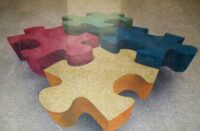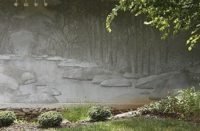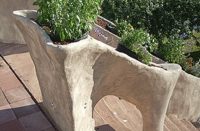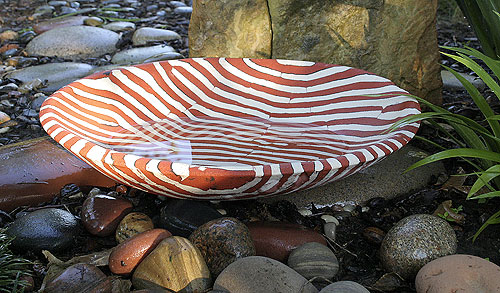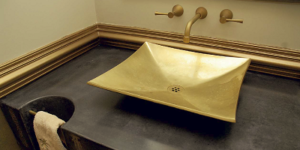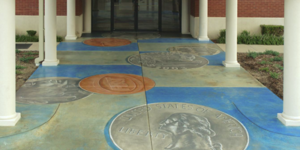Deborah Brackenbury is no stranger to art — she’s been a photographer since the 1980s. But after a search for the perfect birdbath fell short, she made herself into a concrete artisan.
“With an extensive garden, I wanted to provide birds and wildlife with abundant water, but when I began to look for birdbaths I was at a loss to find any that had the sleek, elegant look I wanted,” says Brackenbury.
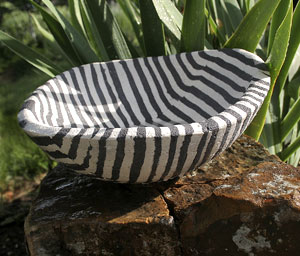 So she decided to take matters into her own hands and create a birdbath using hypertufa, a combination of cement, sand and lightweight aggregate such as peat moss or perlite.
So she decided to take matters into her own hands and create a birdbath using hypertufa, a combination of cement, sand and lightweight aggregate such as peat moss or perlite.
From there, Brackenbury’s love for art inspired her to read about constructing small-scale concrete pieces and experimenting with different mixes and forms. Now she is owner of Impure Vessels, a company that specializes in concrete vessels, primarily bowls, vases and plates.
Brackenbury makes her vessels by mixing white portland cement with white sand, lime and metakaolin, creating a clay-like consistency. Then she divides the cement mixture into two to four portions, adding a powder colorant to each section. Next, inspired by her love of baking, she rolls out the colored portions like cookie dough.
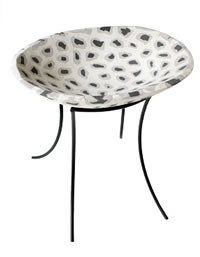 Depending on the piece, she will use cookie cutters to cut out shapes or stack different colors of concrete and form them into a cinnamon roll shape. After the concrete rests for a few hours, Brackenbury will scrape and carve the vessel, then clean the bottom side with a file after it has time to set.
Depending on the piece, she will use cookie cutters to cut out shapes or stack different colors of concrete and form them into a cinnamon roll shape. After the concrete rests for a few hours, Brackenbury will scrape and carve the vessel, then clean the bottom side with a file after it has time to set.
Having never worked with concrete before, Brackenbury ran into many challenges.
“Since the vessel needs to be cleaned while still green, it is very easy to unmold too soon and destroy the piece,” she says. “Also, before discovering scraping and carving the green piece, I attempted to work by keeping each piece of cut concrete clean — that was an insane process.”
Now Brackenbury has mastered the process and is able to create two pieces per day, excluding the fact that each piece must cure and be waterproofed, a process that takes about three weeks. She estimates that she has made around 40 successful pieces.
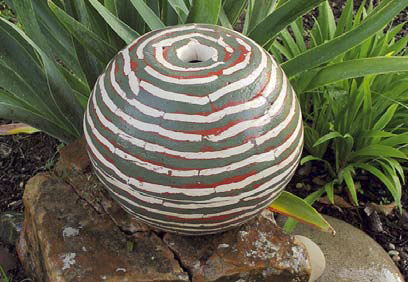 “Perhaps, as with most artists, my favorites tend to be my most recent successes,” says Brackenbury. “Every time I resolve a new design it’s an exciting moment and helps me build on the next piece. I rarely make two pieces alike, because the most interesting part about working the way I do is creating a new form and design.”
“Perhaps, as with most artists, my favorites tend to be my most recent successes,” says Brackenbury. “Every time I resolve a new design it’s an exciting moment and helps me build on the next piece. I rarely make two pieces alike, because the most interesting part about working the way I do is creating a new form and design.”
Because each vessel is treated with food-safe waterproofing, it can be used for everything from a birdbath to a serving platter. Indoor pieces can be washed with soap and water, but when washing an outdoor vessel a bleach solution should be used to destroy algae growth and bacteria harmful to animals.
Although Brackenbury says the most exciting part about creating the vessels is the planning and execution of the design, she also enjoys the reaction of her customers.
“Most people think of concrete as a simple, crude building material, the stuff of grey sidewalks and building blocks, so I love the surprise that comes when people see how it can be used to make intriguing works of art, she says.
(405) 414-8662
www.impurevessels.com
